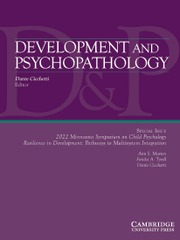Crossref Citations
This article has been cited by the following publications. This list is generated based on data provided by
Crossref.
Charman, Tony
Carroll, Frances
and
Sturge, Claire
2001.
Theory of mind, executive function and social competence in boys with ADHD.
Emotional and Behavioural Difficulties,
Vol. 6,
Issue. 1,
p.
31.
Loveland, Katherine A.
Pearson, Deborah A.
Tunali-Kotoski, Belgin
Ortegon, Juliana
and
Gibbs, M. Cullen
2001.
Judgments of Social Appropriateness by Children and Adolescents with Autism.
Journal of Autism and Developmental Disorders,
Vol. 31,
Issue. 4,
p.
367.
Silver, Miriam
and
Oakes, Peter
2001.
Evaluation of a New Computer Intervention to Teach People with Autism or Asperger Syndrome to Recognize and Predict Emotions in Others.
Autism,
Vol. 5,
Issue. 3,
p.
299.
Brüne, Martin
2001.
Social Cognition and Psychopathology in an Evolutionary Perspective.
Psychopathology,
Vol. 34,
Issue. 2,
p.
85.
Serra, M.
Loth, F.L.
Van Geert, P.L.C.
Hurkens, E.
and
Minderaa, R.B.
2002.
Theory of mind in children with `lesser variants' of autism: a longitudinal study.
Journal of Child Psychology and Psychiatry,
Vol. 43,
Issue. 7,
p.
885.
Perner, Josef
Kain, Winfried
and
Barchfeld, Petra
2002.
Executive control and higher‐order theory of mind in children at risk of ADHD.
Infant and Child Development,
Vol. 11,
Issue. 2,
p.
141.
Hillier, Ashleigh
and
Allinson, Lesley
2002.
Beyond Expectations.
Autism,
Vol. 6,
Issue. 3,
p.
299.
Kißgen, R.
and
Schleiffer, R.
2002.
Zur Spezifitätshypothese eines Theory-of-Mind Defizits beim Frühkindlichen Autismus.
Zeitschrift für Kinder- und Jugendpsychiatrie und Psychotherapie,
Vol. 30,
Issue. 1,
p.
29.
Serra, Marike
2002.
Verwerking van sociale informatie bij kinderen met pervasieve ontwikkelingsstoornissen: theorieën en modellen.
Dth,
Vol. 22,
Issue. 2,
p.
52.
Volkmar, Fred R
and
Pauls, David
2003.
Autism.
The Lancet,
Vol. 362,
Issue. 9390,
p.
1133.
Sodian, Beate
Hülsken, Christian
and
Thoermer, Claudia
2003.
The self and action in theory of mind research.
Consciousness and Cognition,
Vol. 12,
Issue. 4,
p.
777.
Fahie, Carleen M
and
Symons, Douglas K
2003.
Executive functioning and theory of mind in children clinically referred for attention and behavior problems.
Journal of Applied Developmental Psychology,
Vol. 24,
Issue. 1,
p.
51.
Kohler, Christian G.
Turner, Travis H.
Gur, Raquel E.
and
Gur, Ruben C.
2004.
Recognition of Facial Emotions in Neuropsychiatric Disorders.
CNS Spectrums,
Vol. 9,
Issue. 4,
p.
267.
Serra, Marike
2004.
Denken over denken, willen en voelen.
Kind en Adolescent Praktijk,
Vol. 3,
Issue. 2,
p.
104.
Althaus, Monika
Van Roon, Arie M.
Mulder, Lambertus J.M.
Mulder, Gijsbertus
Aarnoudse, Cecilia C.
and
Minderaa, Ruud B.
2004.
Autonomic response patterns observed during the performance of an attention‐demanding task in two groups of children with autistic‐type difficulties in social adjustment.
Psychophysiology,
Vol. 41,
Issue. 6,
p.
893.
Symons, Douglas K
2004.
Mental state discourse, theory of mind, and the internalization of self–other understanding.
Developmental Review,
Vol. 24,
Issue. 2,
p.
159.
Downs, Andrew
and
Smith, Tristram
2004.
Emotional Understanding, Cooperation, and Social Behavior in High-Functioning Children with Autism.
Journal of Autism and Developmental Disorders,
Vol. 34,
Issue. 6,
p.
625.
Solomon, Marjorie
Goodlin-Jones, Beth L.
and
Anders, Thomas F.
2004.
A Social Adjustment Enhancement Intervention for High Functioning Autism, Asperger?s Syndrome, and Pervasive Developmental Disorder NOS.
Journal of Autism and Developmental Disorders,
Vol. 34,
Issue. 6,
p.
649.
Brent, Ella
Rios, Patricia
Happé, Francesca
and
Charman, Tony
2004.
Performance of Children with Autism Spectrum Disorder on Advanced Theory of Mind Tasks.
Autism,
Vol. 8,
Issue. 3,
p.
283.
Bruning, Nicole
Konrad, Kerstin
and
Herpertz-Dahlmann, Beate
2005.
Bedeutung und Ergebnisse der Theory of Mind-Forschung für den Autismus und andere psychiatrische Erkrankungen.
Zeitschrift für Kinder- und Jugendpsychiatrie und Psychotherapie,
Vol. 33,
Issue. 2,
p.
77.

